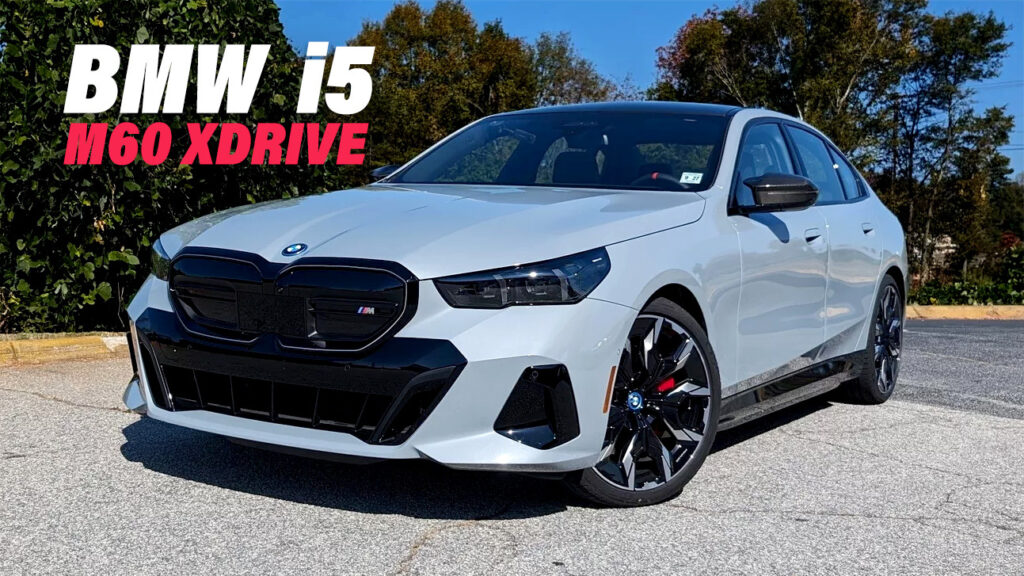We drove the 593 hp M60 xDrive version on the road and on the race track and found out all there is to know about the new all-electric 5-Series
6 hours ago
 –>
–> 
–>
BMW says that it’s all in on electrification and the new i5 signals that a little more clearly. As the very first all-electric 5-Series variant, it’s a bold new step as part of the all-new eighth generation of the model. It comes in two distinct flavors that start at just under $67,000 before destination and handling. For now, the i5 M60 xDrive, which costs north of $64,900, serves as the top dog in the 5-Series lineup and we just tested it.
Over the course of three days in South Carolina near BMW’s Spartanburg plant we drove it both on the road and on the track. We tested everything from how well it handles traffic to back roads and everyday tasks. As it prepares to take on other electrified cars in the segment it’ll need to compete on every level while maintaining its historic DNA. Does the i5 take the reins of the 5-Series moniker and race out of the gates? Or is it a stumbling start? Read on to find out.
Two Trims And Two Drivetrains
Photos Stephen Rivers / Carscoops
The i5 lineup begins with the eDrive40, a rear-wheel drive version with 335 hp and 295 lb-ft of torque. That powertrain is good enough to help the car run from 0-60 mph (0-96 km/h) in just 5.7 seconds and onto an electronically limited top speed of 120 mph (193 km/h). Buyers have the option to add an M Sport package to it that includes a “Boost” button on the left steering-wheel-mounted paddle. When activated, the i5 makes 317 lb-ft of torque for up to 10 seconds. A launch control mode is also available. Both versions of the i5 share the same 82 kWh battery and the rear-wheel drive model can go up to 295 miles (475 km) on a single charge.
We piloted the i5 M60 xDrive though and it offers a lot more performance and a little less range. Dual motors, one on each axle, combine to make 593 hp and 550 lb-ft of torque. It cuts a full two seconds off of the 0-60 time of the eDrive40 (3.7 seconds for the M60) and has an electronically limited top speed of 143 mph (230 km/h). Just like the eDrive40, the M60 xDrive has a Boost function but in this case, it comes standard. It also enables 605 lb-ft of torque for short bursts. Range drops to just 256 miles (412 km) in the M60 though.
advertisement scroll to continue
Both benefit from DC fast charging capability which can boost the battery level from 10 percent to 80 in about 30 minutes. First-time owners get two years of complimentary charging at the Electrify America DC network. Power isn’t the only benefit of the i5 though. This sedan has everything one might expect from a modern BMW saloon car.
A Refined But Not Overtly EV Interior
Photos Stephen Rivers / Carscoops
BMW’s design language is clear in the cabin of the i5. The widescreen display housing the infotainment and driver information screen bends slightly toward the pilot and the dash follows. Three clean lines of material, carbon, metal, and composite define the forward view and a flat-bottomed tri-spoke steering wheel provides directional control. The center console features a crystalized iDrive interface with capacitive buttons for navigation.
The seats are a mix of upholstery surfaces including leather, cloth, and Alcantara. Contrast stitching makes its way onto them along with the wheel and door cards. As this is an “M”60 it gets a few little nods to the famous performance off-shoot. That includes an M badge on the wheel and a small tri-color fringe on the front seats. This is certainly a forward-looking BMW interior but it isn’t above clever callbacks to the past.
The seats themselves are comfortable and supportive. Interestingly, BMW blends seat controls between physical switches on the side of the seat cushion and digital controls in the infotainment system. Frankly, that’s a bit frustrating. Even once one uncovers the additional adjustments in the menu, the seats aren’t as configurable as we expected from a model that sits near $90,000. The rear seats offer ample headroom and legroom even for those over six feet tall. That shouldn’t come as too much a surprise though as the i5 is longer and wider than an E32 7-Series.
The Bowers & Wilkins sound system and the panoramic sunroof each offer additional luxuries for all in the cabin to enjoy. The rearward-facing portion of the front seat backrest offers BMW’s clever attachment port along with a USB-C power plug-in. Two additional USB-C ports sit between the seats and under the climate vents. Overall, it’s a clever cabin with modern touches, advanced technology, and a lot of luxury baked in.
Behind the second row, the trunk offers 17.3 cubic feet of storage space. That’s a bit less than one will find in the gas-powered 5-Series (18.4) but it’s more than enough for a few golf bags or whatever else one might transport in such a car. The second-row seat folds down 40/20/40 for maximum configurability.
Technological Refinements
The new i5 comes with BMW’s iDrive 8.5 which is by far the best iteration to date. It allows users to interface with it via touch controls, physical buttons and knobs, gesture control, and voice activation. All that’s left is for BMW to let you control it with your mind. Beyond the interface itself, the system is rich, featureful, and mostly easy to navigate. Android Auto and Apple CarPlay continue to be available for those who prefer to use them.
A color heads-up display adds to the luxury and tech-forward nature of the i5. It combines with the 14.9-inch driver information display and the 12.3-inch infotainment system to provide a wide array of vehicle information at one time. The heads-up system can also show augmented reality turn-by-turn driving directions when the integrated navigation system is in use.
We found the nav system to work well once a destination was set. Sadly, much the same way we experienced odd predictions in our Kia Carnival review, BMW’s nav system sometimes predicted that we wanted to go to odd places that just happened to be outside of the state before it would show local options.
Finally, the driver-aids are fantastic. BMW recently introduced a new feature on its highway assist hands-free driving system that enables lane changes. If the car senses that it’s coming up on a car that’s going slower than the cruise is set to, and there’s a free lane, it’ll suggest a lane change and the driver can accept it simply by turning their head and looking in that direction. It’s wild but very functional and smooth. The normal adaptive cruise, lane-keep assist, and blind-spot monitoring all work seamlessly too.
Driving The Biggest 5-Series To Date
BMW also offers a host of M Performance parts for the i5 (Photos BMW)
There’s no question that the i5 feels like a 5-Series from the driver’s seat when stationary. On the road, it’s a bit of a different animal though. This is the biggest 5-Series to date. It is, in fact, bigger in every physical dimension and that’s part of where it departs from older generations. BMW said multiple times that it now has more presence on the road thanks to that extra size. Does it have more presence than an E39 or an E60? I’d argue it doesn’t as both of those cars were lighter, more nimble, and felt more playful.
By comparison, the i5 M60 xDrive is just gargantuan. It tips the scales at just over 5,200 pounds. In other words, it’s half a ton heavier than the E60. As a former E60 5-Series owner, I can confirm that you can feel that heft from behind the wheel.
The steering feels pretty good for an EV but you can feel the extra weight that you’re reigning in as you see-saw at the wheel on track. The brakes deserve extra praise for being the best I’ve ever experienced on an EV in extreme conditions. They’re strong, easy to modulate, and allow for threshold braking without automatically kicking the ABS on.
On the very positive side, it still feels very much like a BMW in the way that it handles and exits corners. The 593 ponies baked into the chassis are no doubt part of that success. Other key features like rear active steering, active roll stabilization, and stroke-dependent dampers, all help it to feel rear-drive biased as it should. And despite lapping the i5 over and over and over it didn’t appear to lose power or snap off of the line. On the public roads, the i5 feels even better though.
I won’t kid you when I say that it feels incredibly competent in traffic. Having driven the Kia EV6 GT, the Audi Q8 e-tron, and many Tesla Performance models I can honestly say that the i5 M60 xDrive feels quicker than most. It’s a weapon on the road that allows its driver to be wherever they want whenever they want. Of course, if they want to be in a tight parking space or a packed city street they might want to go slow and watch those corners.
Competition
The i5 is the biggest 5-Series to date in more than just inches and feet. It’s also the biggest shift the brand has ever truly made with this car. Sure, it’s gone after some big bold design changes in the past but this is a whole new animal with new DNA.
The i5 is set to do battle with the Mercedes-Benz EQE, the base Tesla Model S, the Genesis Electrified G80 and other up-and-coming EVs. To that end, it’s probably going to do very well with the modern BMW customer. In fact, due to how configurable and customizable it is, we expect it to take sales from a few other brands as well. It’s got something on every one of the above-mentioned cars.
Final Thoughts
The 2024 BMW i5 is a major move for the brand and it’s one that still has enough 5-Series DNA in it that it’ll likely do very well at dealerships. The exterior design is unique to the family and helps to define the 5-Series almost as its own sub-brand which is good. The interior and driving experience also speaks well to the attention and intention of this new 5-Series generation. Do we wish it was smaller? Yes. But there’s always the i4 for those who want a more compact electric BMW.


